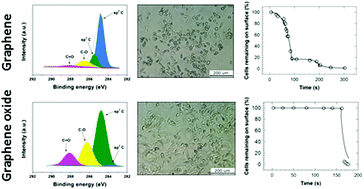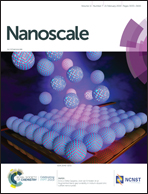Flow induced HeLa cell detachment kinetics show that oxygen-containing functional groups in graphene oxide are potent cell adhesion enhancers†
Abstract
A broader and quantitative understanding of cell adhesion to two-dimensional carbon-based materials is needed to expand the applications of graphene and graphene oxide (GO) in tissue engineering, prosthetics, biosensing, detection of circulating cancer cells, and (photo)thermal therapy. We therefore studied the detachment kinetics of human cancer cells HeLa adhered on graphene, GO, and glass substrates using stagnation point flow on an impinging jet apparatus. HeLa cells detached easily from graphene at a force of 9.4 nN but adhered very strongly to GO. The presence of hydrophilic functional groups thus apparently enhanced the HeLa cells’ adherence to the GO surface. On graphene, smaller HeLa cells adhered more strongly and detached later than cells with larger projected areas, but the opposite behavior was observed on GO. These findings reveal GO to be a suitable platform for detecting cells or establishing contacts, e.g. between graphene-based circuits/electrodes and tissues. Our experiments also show that the impinging jet method is a powerful tool for studying cellular detachment mechanisms and adhesion strength, and could therefore be very useful for investigating interactions between cells and graphene-based materials.



 Please wait while we load your content...
Please wait while we load your content...